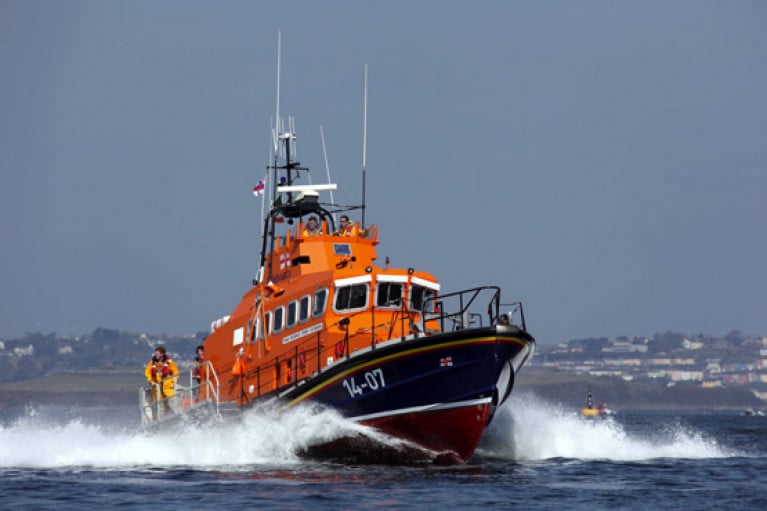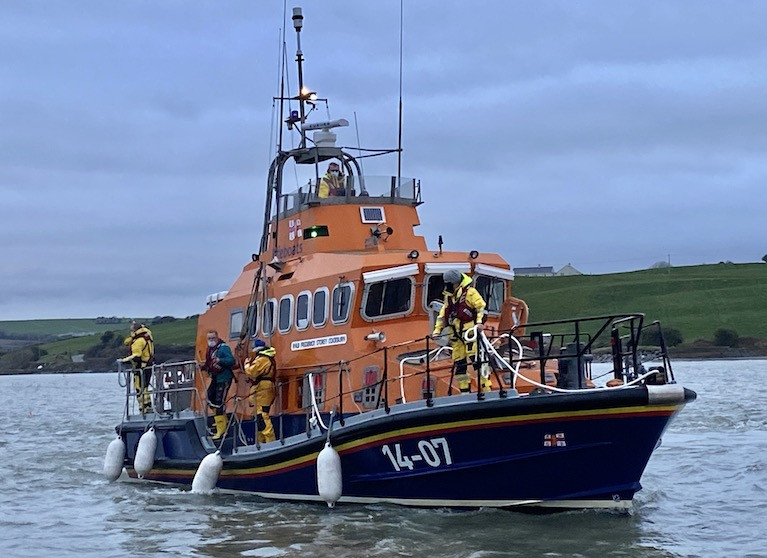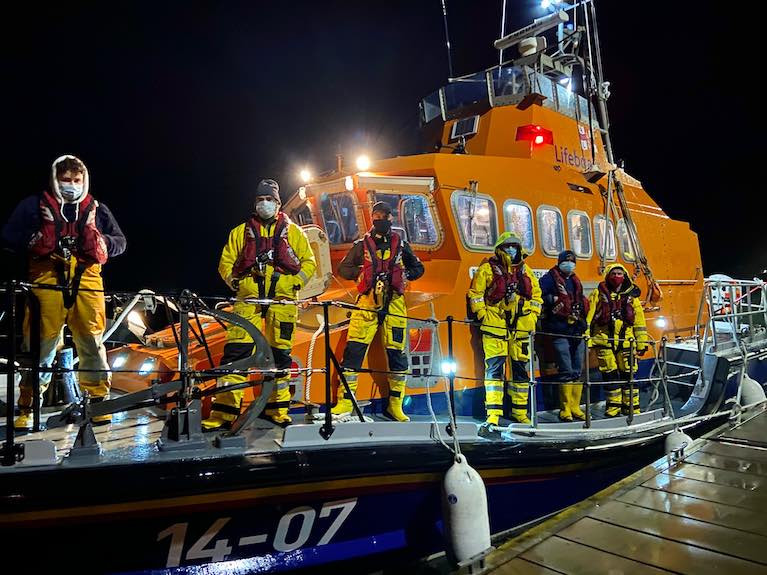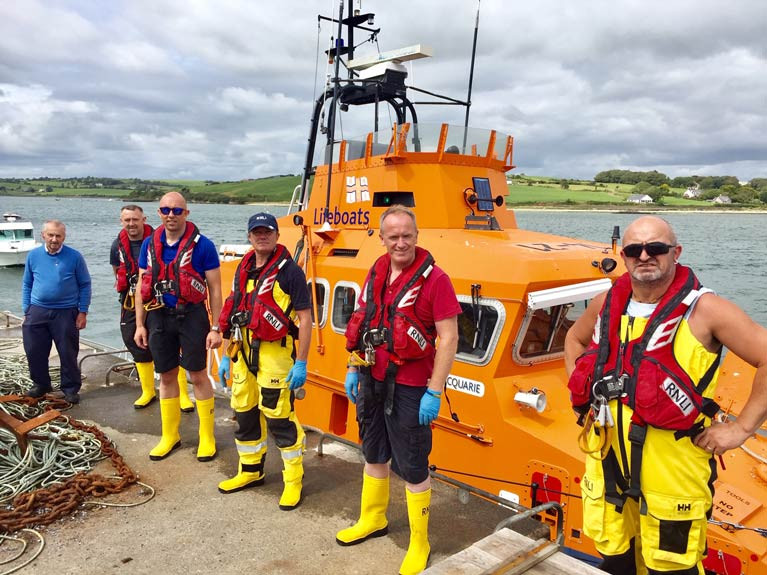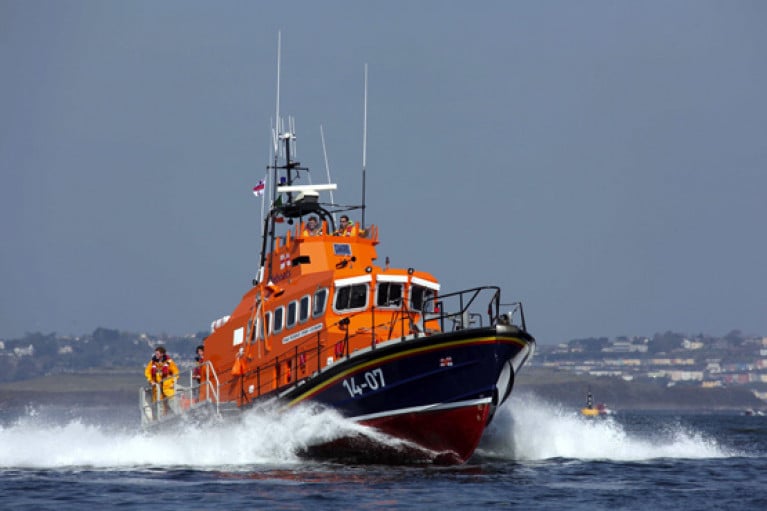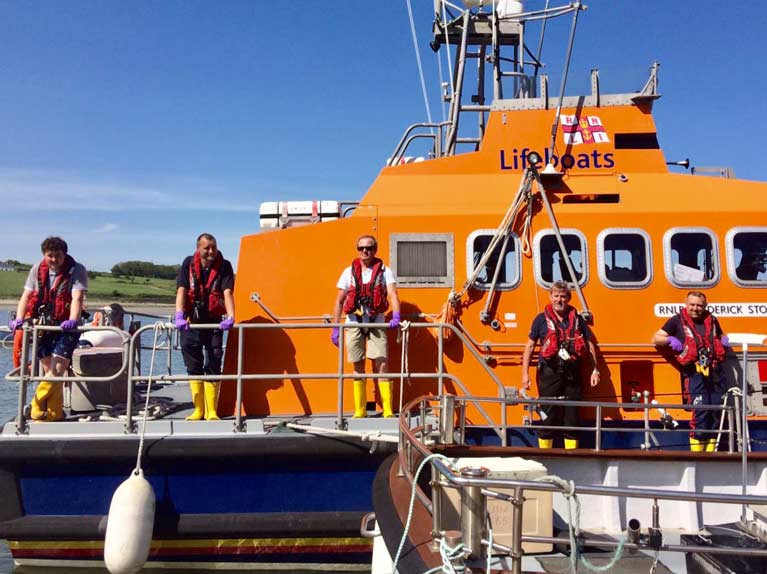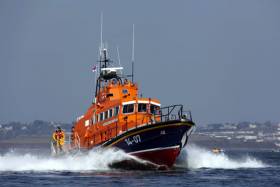Displaying items by tag: Courtmacsherry
Courtmacsherry Lifeboat Launches to Surfer in Difficulty
Courtmacsherry RNLI’s all-weather lifeboat was called out yesterday afternoon (Sunday 21 February) to a surfer in difficulty off Garrettstown Beach near the Old Head of Kinsale.
The Trent class lifeboat with a crew of five was under way within minutes of the 3.40pm call.
However, upon reaching the scene less than 15 minutes later, they learned that the surfer had managed to get ashore with the help of family members.
“It was great to see the fast response of so many of our volunteer crew again today, when their bleepers activated, which ensured that we were at the scene very quickly,” said Brian O'Dwyer, Courtmacsherry RNLI volunteer lifeboat operations manager.
Elsewhere, Fenit RNLI’s volunteer crew were tasked around 1pm to reports of two upturned kayaks in the Banna Strand area.
The station launched both its all-weather and inshore lifeboats, with a full crew on both vessels.
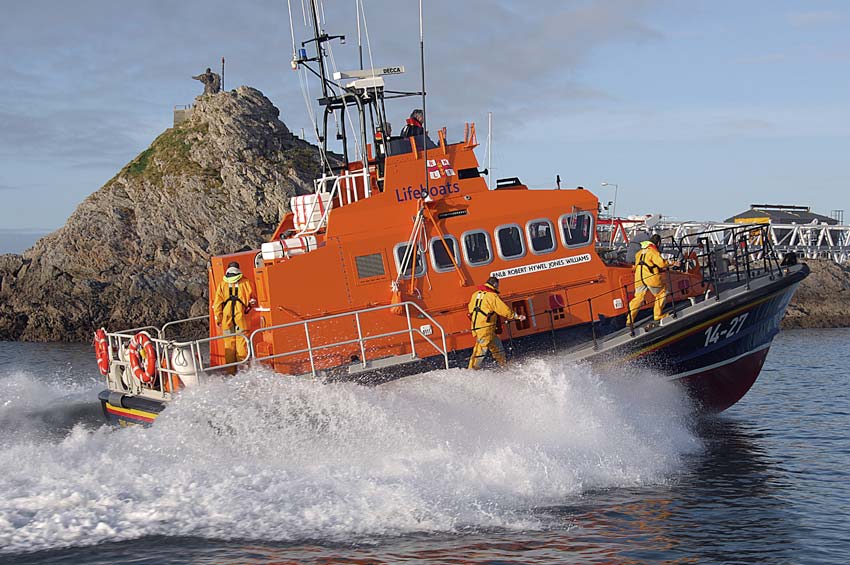 File image of Fenit RNLI’s all-weather lifeboat | Photo: RNLI/Fenit
File image of Fenit RNLI’s all-weather lifeboat | Photo: RNLI/Fenit
On arrival at the scene of the reported sighting, the lifeboat crews were advised that the occupants of the kayaks were safe and accounted for, and their kayaks washed ashore shortly afterwards.
Fenit lifeboat press officer Jackie Murphy said the volunteers “were delighted that there was a safe and positive outcome for all concerned”.
Meanwhile, the RNLI stresses to all those taking part in any water activities or planning a visit to the coast during this extended lockdown to follow its water safety advice below, along with all new Government regulations, and stay safe in these different times for all rescue services:
- Have a plan — check the weather forecast, tide times and read local hazard signage.
- Keep a close eye on your family — on the beach, on the shoreline and in the water.
- Don’t allow your family to swim alone.
- Don’t use inflatables at all, at all on the sea.
- Make sure to wear a lifejacket at all times when taking to the sea in a boat.
- If you fall into the water unexpectedly, FLOAT TO LIVE. Fight your instinct to thrash around, lean back, extend your arms and legs, and float.
- In an emergency dial 999 or 112 immediately and ask for the coastguard. The rescue services are there to help you all.
Courtmacsherry RNLI Lifeboat Rescue Windsurfer 1km Offshore Near Old Head of Kinsale
The Courtmacsherry All-Weather Trent Class RNLI Lifeboat was called out this afternoon at 4.10 pm at to go to the immediate aid of a windsurfer who got into difficulty over one kilometre from shore off Garrylucas Strand near the Old Head of Kinsale in West Cork.
The Courtmacsherry lifeboat under Coxswain Sean O'Farrell and crew of four were underway within minutes and proceeded at full speed to the area of the casualty in rough conditions at sea this afternoon. The lifeboat reached the casualty, who was being blown out to sea, within 15 minutes, and the crew immediately plucked him from the choppy seas to the safe surround of the lifeboat. Once onboard the Lifeboat and assessed by the crew, he was immediately wrapped in blankets etc and brought back at speed to the Courtmacsherry Harbour Pontoon where he was transferred to the RNLI Station House for some further observation in a warm surrounding. He was really glad to be safely ashore and appreciated some hot drinks from Station Crewman Micheal Hurley, after a difficult 45 minutes in the cold rough water. The conditions at sea this afternoon were difficult with offshore winds haven risen in the afternoon and a rough sea developing.
Thankfully a happy ending as his mother travelled by car to collect him from the Station house, with both praising the swift action of the RNLI Lifeboat in carrying out the rescue.
The Coastguard Rescue 115 Helicopter was also tasked to assist in today’s incident.
Commenting on the callout, the Courtmacsherry RNLI Voluntary Lifeboat Operations Manager Brian O'Dwyer thanked all the Lifeboat voluntary crewmembers for the quick response to the Station’s second callout in 24 hours, and carrying out the Rescue so quickly in difficult conditions. He reiterated that is so important to call the rescue services at 112 or 999 quickly once any incident like this occurs and today this resulted in a very fast response to the scene by the rescue services.
The Courtmacsherry Lifeboat Crew involved in today’s callout were Coxswain Sean O Farrell, Mechanic Tadgh McCarthy and crew Paul McCarthy, Denis Murphy and Jim O' Donnell.
Courtmacsherry RNLI Lifeboat in Callout to Person Requesting Assistance on Boat in Clonakilty Harbour
The Courtmacsherry All-Weather Trent Class RNLI Lifeboat was called out this Friday evening to assist a man who was in difficulty on board a boat in Ring Harbour near Clonakilty, West Cork. The Courtmacsherry Lifeboat under Coxswain Sean O'Farrell and crew of five proceeded to the area of the causality which was upstream past North Ring Pier on the Clonakilty estuary. The man on board the boat required immediate attention and both the Lifeboat and the Coastguard 115 Helicopter were on scene just after 5 pm.
Assisting in this evenings callout were the Coastguard ground Unit from Castlefreke, the Rapid Response Team and the Clonakilty Fire Brigade along with local personnel etc. In a difficult situation, on dangerous coastline terrain, the man was successfully airlifted from the Boat by Rescue 115 and taken to Cork University Hospital. The Lifeboat stood by as the operation was carried out in the shallow waters just off Inchydoney Island.
Commenting on the callout, the Courtmacsherry RNLI Voluntary Lifeboat Operations Manager Brian O'Dwyer thanked all the Lifeboat crew members for their professionalism throughout this multi-agency rescue. He praised the great dedication of the Crew Members and others who arrived and put the interests of the injured party as a priority in these difficult Covid times. He again reiterated that it is so important to call the rescue services at 112 or 999 quickly once any incident like this occurs
Courtmacsherry RNLI Lifeboat in Call Out to 50ft Yacht in Difficulties off the Old Head of Kinsale
The Courtmacsherry All-Weather Trent Class RNLI Lifeboat was called out at 7 am this Sunday morning to go to the aid of a 50 ft-yacht with three people on board which had got into difficulties four miles east of the Old Head of Kinsale in West Cork.
The Courtmacsherry Lifeboat under Coxswain Mark Gannon and crew of 6 were underway within minutes and in the cover of darkness, the Lifeboat proceeded at top speed to the area of the causality. Winds were blowing force 4 to 5 in freezing conditions this morning and the stricken vessel, which was on passage from Salcolme in the UK to Kinsale, had encountered heavy weather over the past 24 hours.
They lost complete power off the Old Head of Kinsale and requested immediate assistance.
The Lifeboat reached the yacht at 7.29 am and the Lifeboat crew assessed the situation and quickly proceeded to attach a tow line to secure the vessel. Two Lifeboat crew members Kevin Young and Paul McCarthy were also put on board the yacht to help those on board and the Lifeboat then proceeded at slow speed to the safe surround of the inner Kinsale Harbour. Both vessels docked safely at the Kinsale Yacht Club Marina at 9.05 am and the crew on board the yacht were very glad to be on safe ground again after an eventful morning.
 Courtmacsherry RNLI Lifeboat crew after today's call out
Courtmacsherry RNLI Lifeboat crew after today's call out
Commenting on the callout, the Courtmacsherry RNLI Voluntary Lifeboat Operations Manager Brian O'Dwyer thanked all the Lifeboat crew members for their quick response from their beds early this freezing morning when the Coastguard activated the distress bleepers. He praised the great dedication of the seven volunteer Crew members and others who arrived, and put the interests of others as a priority in these difficult Covid times. He again reiterated that it is so important to call the rescue services at 112 or 999 quickly once any incident occurs.
The Courtmacsherry Lifeboat crew involved in this morning’s callout were Coxswain Mark Gannon, Mechanic Tadgh McCarthy and crew Ken Cashman, Kevin Young, Paul McCarthy, Peter Noonan and Denis Murphy.
The Lifeboat has now returned to its base in Courtmacsherry at 10 am and has refuelled and restocked, in readiness of whenever the next call to action may occur.
A sea angler got more than he bargained for last week when he was thrown from his boat by a whale while fishing off West Cork.
As CorkBeo reports, Cris Lane was angling with friend Dave McCann off Courmacsherry last Monday (3 August) when they noticed a bounty of marine wildlife — both dolphins and small whales — close by, and their vessel was bumped by a passing minke whale.
The hit was enough to send Lane flying overboard — but thanks to his lifejacket keeping him buoyant, he was able to quickly get out of the cold water and back on board.
CorkBeo has much more on the story HERE.
The Courtmacsherry All Weather Trent Class RNLI Lifeboat was called out at 12.54 pm this Saturday afternoon to go to the aid of two Kayakers who got into difficulties, in breezy conditions, off the headland of Dunworley Point on the Seven Heads Coastline in West Cork.
The two Kayakers were blown on to the remote rugged, rocky headland of Birds Island off Dunworley, about 7 miles from Clonakilty, and found themselves seeking immediate assistance, as they had to abandon their Canoes.
The Courtmacsherry Lifeboat under Coxswain Micheal O Donovan and crew were underway within minutes and immediately proceeded to the area where the alert was raised. Also tasked by Valentia Radio was the Rescue 115 Coastguard Helicopter and the local Seven Heads Coastguard Unit.
The two casualties managed to get onto the rocks after their frightening ordeal and climbed the cliffside to get onto some firm ground. The Lifeboat and Helicopter arrived on scene and the Helicopter landed on the headland to access the injuries to the two persons. The Lifeboat recovered paddles from the Kayaks and remained on the scene until the Helicopter airlifted one of the casualties to Hospital and the other person was taken to nearby safe terrain by the Coastguard unit.
 Courtmacsherry RNLI all-weather lifeboat on scene at Dunworely Headland
Courtmacsherry RNLI all-weather lifeboat on scene at Dunworely Headland
Commenting on this afternoon’s callout, the Courtmacsherry RNLI Voluntary Deputy Launching Authority Diarmuid O Mahony, along with the Seven Heads Coastguard unit spokesman Eamonn Barry thanked all the Lifeboat and Coastguard crew members for their quick response today and carrying out the rescue and assistance very professionally, in what could have been a very serious incident. They reiterated and thanked those in trouble for their quick action in seeking immediate help and assistance, as minutes matter and it is always vital to alert the Coastguard quickly when in difficulty.
The Courtmacsherry Lifeboat Crew involved in today’s callout were Coxswain Micheal O Donovan, Mechanic Tadgh McCarthy and crew members Dara Gannon, Ken Cashman, Denis Murphy and Mark John Gannon.
Courtmacsherry Lifeboats Launch To Windsurfer in Difficulty
Courtmacsherry RNLI’s lifeboat volunteers were called out at 3.50pm yesterday afternoon (Saturday 20 June) to go to the aid of a lone windsurfer who had got into difficulty just offshore of Harbour View in Courtmacsherry Bay.
The alarm was raised by concerned persons on shore that the surfer was unable to return to his base as the winds were escalating.
While the winds were beginning to blow a gale off the South West Coast, both the Trent class lifeboat and the station’s inshore lifeboat were launched under coxswain Mark Gannon and a combined crew of nine volunteers.
After conducting a thorough search of the coastline from Burren Pier to Coolmain Strand, the windsurfer was finally located as he got ashore by himself downstream of Harbour View. The crew of the inshore lifeboat approached to confrm his status and found he was tired but uninjured.
Lifeboat operations manager Brian O’Dwyer thanked all the lifeboat crew members for the quick response and carrying out the search operation in a very professional fashion.
He reiterated that it is always best to raise the alarm quickly in the event of a difficulty being spotted from shore by dialling 999 or 112 and asking specifically for the coastguard.
Courtmacsherry RNLI Lifeboat in Call Out to Swimmers in Difficulty off Inchydoney Island, West Cork
The Courtmacsherry All-Weather Trent Class RNLI Lifeboat was called out at 2.10 pm this afternoon to go to the aid of swimmers who had got into difficulty off Virgin Mary’s Bank in Inchydoney Island, West Cork.
Under Coxswain Sean O Farrell and a crew of five, the Courtmacsherry Lifeboat was underway very quickly, under the Station’s new COVID-19 Launch protocols and immediately made its way at top speed to the area of the causalities. Also mobilised was the local Irish Coastguard Unit from Castlefreke, the Coastguard Rescue 115 Helicopter from Shannon and the Local HSE Ambulance. Four persons were swimming together when two got into difficulty. The others made the shoreline and raised the alarm by immediately contacting the rescue services.
Thankfully the two swimmers in difficulty were later able to get ashore where they were assessed by the rescue services, following a very traumatic ordeal. All four were hugely appreciative of the responses of the Rescue Services.
Commenting on this afternoon’s callout, the Courtmacsherry RNLI Voluntary LPO Vincent O Donovan thanked all the Lifeboat crewmembers and Station Officers for ensuring a safe callout today. He commented that “It was also vital that the call for help to the Rescue services was made as quickly as possible as vital minutes can be so important in all rescues”.
The crew on board this afternoon’s call out were Coxswain Sean O Farrell, Mechanic Stuart Russell and crew members Tadgh McCarthy, Dara Gannon and Evin O Sullivan. Of note was that five other crewmembers were quickly at the station in order to give any help required. Attached is a picture of the Lifeboat crew after returning to base.
Busy Weekend For West Cork Lifeboats In Baltimore & Courtmacsherry
Following last Thursday’s launch to a sailing dinghy aground on an island near Baltimore Harbour, the local RNLI crew were called out twice on Sunday (22 September), with the first to other boat aground in the harbour.
The inshore lifeboat was on scene in a matter of minutes after they were notified that the 14m sailing boat had run up on rocks at the harbour’s edge.
Volunteer crew set up a tow line to return the vessel to deeper water and, once it was checked over for damage, the lifeboat towed the yacht head to wind to let its crew set their sails.
Baltimore’s inshore lifeboat launched again at 3.36pm to assist a RIB with five people on board which broke down and was at anchor off Castle Point, near Schull Harbour.
However, while en route the lifeboat was stood down after word came through that the RIB’s occupants had managed to get themselves under way.
Elsewhere, in West Cork, Courtmacsherry’s all-weather lifeboat launched on Saturday evening (21 September) as bad weather unfolded to rescue a surfer in difficulty off Inchydoney.
As the lifeboat was speeding across Clonakilty Bay to the reported location, its crew were informed that the surfer had managed to get ashore safe and well.
Deputy launching authority Diarmuid O’Mahony praised those on shore who called for help for their quick alert: “Vital minutes today could have been so important in sea conditions that were very poor.
“I also want to commend all the volunteer crew who responded so quickly in coming to the lifeboat station in the knowledge that they were going to face some mountainous seas and difficult conditions off the coast.”
As previously reported, Crosshaven RNLI also launched yesterday to two sailors whose catamaran dinghy capsized in Cork Harbour yesterday evening.
Courtmacsherry RNLI was among the search and rescue agencies who responded yesterday morning (Thursday 8 August) to reports that a man had taken ill during a diving expedition to the wreck of the Lusitania.
As reported by The Irish Times, it is suspected that the diver, one of a group of eight, developed the bends as he returned to the surface from the wreck site some 18km off the Old Head of Kinsale.
The Naval Service vessel LÉ George Bernard Shaw diverted from patrol in the area and sent a team to bring the casualty on board, from where he was airlifted to hospital.
Later the casualty was transferred from Cork University Hospital to University Hospital Galway, which has a decompression unit.
As the emergency operation wound down, Courtmacsherry RNLI’s all-weather Trent class lifeboat Frederick Stormy Cockburn received another Mayday call, to a 30ft yacht in difficulty off the Seven Heads coast.
The lifeboat was at the scene within 20 minutes and proceeded to tow the stricken vessel back to the safe surrounds of Courtmacsherry Pier.
Commenting on the morning’s callouts, Courtmacsherry lifeboat operations manager Brian O'Dwyer praised all the crew for their professionalism and fast response.
Elsewhere, shortly after 1pm, Crosshaven lifeboat volunteers were called to a medical evaluation from Spike Island in Cork Harbour.
According to Crosshaven RNLI, crew member Aoife Dinan performed casualty care until paramedics arrived, having been brought to the Island by the Port of Cork RIB.
The Irish Community Air Ambulance also landed on the island along with Crosshaven Coast Guard.
“Very sadly, the male casualty, who was a foreign visitor, was declared deceased,” said press officer Jon Mathers. “Our sympathies are with the family of the deceased man; may he rest in peace.”


























